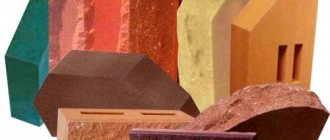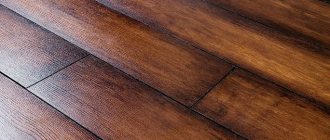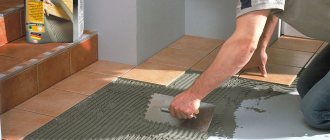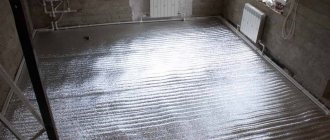Laminate is one of the most popular materials used in houses and apartments for renovation. It has excellent performance characteristics and a low price. Due to its excellent cost-quality ratio, it has gained a lot of trust among people. Before working with the material, it is recommended to carefully study the rules for laying laminate flooring. You should take a responsible approach to the preparatory work and installation itself.
The final result after installation work is completed
Laminate characteristics
Like other materials, laminate has parameters that affect its performance characteristics and ease of installation.
The number of boards in the package depends on the size. Coating characteristics:
- thickness;
- length;
- width.
Important! It is generally accepted that the thicker the laminate, the stronger it is. However, it is not. It all depends on the materials used - high-quality panels are based on a high-strength slab.
Manufacturers do not adhere to uniform standards. Therefore, boards have completely different dimensions.
Laminate
The number of planks in the package also varies:
- 5 items;
- 10 pieces;
- 8 pieces is the most common packaging option.
However, focusing on the number of lamellas is wrong. The main thing is to take into account the total area of the lamellas in one package. When purchasing, it is recommended to round the quadrature up. After all, it is unknown how many strips will be needed for trimming. The excess material will be useful later for replacing damaged strips.
Width
This parameter is set by the manufacturer himself. He decides how wide the laminated panels in his batch will be. In this case, the manufactured products can be purely conditionally divided into 3 groups:
- Wide (usually a laminated copy of tiles, from 195 - 350 mm);
- Narrow (imitation parquet, 90 – 160 mm);
- Medium (wood texture, 160 – 195 mm).
Laminate marking
To understand the characteristics of the laminate in question and its features, just look at its markings displayed on the back of the board. There are various indicators:
- Sample class. This indicator makes it possible to select an instance for specific operating conditions (for example, class 32 is suitable for use in commercial premises with medium load).
- Type of lamella connection. The R-CLICK marking is often found, which indicates the possibility of reusing the boards, since no adhesives are used for this connection.
- Type of processing. The image of a plane on the back of the board indicates that visually the panel will imitate the corresponding processing.
- Additional elements. The V icon indicates the presence of a chamfer around the perimeter of the board, as a result of which a natural wood board is imitated (read: “What laminate with a chamfer looks like in the interior”).
- Board lifespan with proper use.
Before choosing a laminate, you need to carefully consider all possible characteristics and know which option is required for a particular case. In addition, it is worth remembering that the cost of identical samples on the market may vary, so it is better to give preference to products from a well-established company.
Laying schemes
Laying laminate boards can be done in several ways:
- Straight parallel. It is carried out relative to one of the walls of the room.
- Diagonal. It is laid at an angle of 45 degrees relative to one of the walls. This type of installation is considered complex, requiring certain skills and abilities from the master.
- With offset.
In some cases, laminate flooring is installed not on the floor, but on the walls. For this purpose, a frame made of metal or wood is used. In addition, the finishing material is fixed with glue or nails.
Standard laminate dimensions
It would seem that laminate has been used for a long time and its dimensions should be standardized. In practice this is not the case. There are no uniform standards for laminate panels. A wide variety of sizes are used, depending on the coating manufacturer. And there are more than enough companies producing this material in the world today. As well as a variety of textures. Although there are “eternal standards”, for example, light oak.
Plank thickness
The stability of the dimensions completely depends on this parameter of the laminate board. When using material with standard dimensions, you can significantly simplify the process of installing laminate flooring, because during the flooring the number of cracks becomes minimal. In addition, the thickness of the module affects the heat conductivity of the floor covering and the resistance to high loads that often arise due to the heavy weight of the furniture.
But the wear resistance class does not depend on the thickness of the strip, since the degree of wear of the protective coating is determined by the characteristics of the laminate itself. Thus, the dimensions of a laminate of class 33 in thickness can be identical to the parameters of a laminate coating of class 31 or 32.
The photo shows the dimensions of the laminate flooring
The standard minimum laminate size is 6 mm. In section it can take a maximum thickness of 12 mm. And this is almost identical to a parquet board, whose thickness is 14 mm. The optimal width is 8 mm. Most often, this standard size is used by many manufacturers when making laminate flooring. But how to lay cork underlay under laminate and how to do this procedure correctly with your own hands is described in this article.
Board width
This parameter of the laminate flooring must be taken into account depending on the room in which the laminate will be installed. If you need to get a surface similar to parquet, you will have to use a narrow structure, the width of which is 90 mm. A material with a width of 330 mm is indispensable when installing a product in the form of tiles or in order to obtain an abstract pattern on the floor.
Today, laminated coating, which in cross-section has a width of 185-195 mm, is very popular. At the same time, the standard sizes of the boards are much wider than the laminate. If you adhere to these dimensions, the resulting flooring will have an attractive appearance and look like natural wood.
Maximum width
As mentioned above, the size of the laminate board can reach 400 mm. The “broad category” is characterized by a wide range of design types. Not only wood is imitated, but also tiles, stone, and various artistic elements. Often this coating is equipped with a chamfer.
The most popular options in this category are:
- 396x396 mm;
- 853x329 mm.
Other square sizes are also very popular. But it is worth noting that wide slats usually cost a little more than narrow and medium ones.
Installing laminate flooring of maximum width is quite difficult. We have to:
- level the floor (a wide covering is often short in length, so it does not hide uneven floors well);
- retreat from the walls by about 10 mm to compensate for possible deformations due to humidity;
- waste more glue.
At the same time, with a wide coverage it is easier to follow a pattern or design. Another tangible advantage of slats with maximum width is their durability. After all, the fewer joints, the less wear.
Minimum width
The minimum laminate width is considered to be products from 90 to 135 mm. Their main advantage is the versatility of their application. They are equally good for residential premises and offices, and their short length and even width do not affect their strength in any way. In addition, narrow slats can hide floor defects. A small difference in height is not a problem for them, unlike wide planks.
The disadvantages include the complexity of installation. Installing the panels themselves is not difficult, but cutting and adjusting them will take a lot of time.
What does width affect?
The size of the laminate significantly affects:
- features of choice;
- operating technique.
At the same time, length, thickness and width have different influencing factors. If the thickness of a laminate floor directly affects its insulating properties, then the width primarily affects the coating pattern. The main features are:
- Panels about 90 mm wide successfully imitate parquet. And they are much cheaper.
- Medium width (up to 160 mm) offers a wide range of designs and is rightfully considered universal.
- Panels wider than 160 mm (and especially two meters or more) are usually used to imitate ceramic or stone coatings.
- Material with a width above 330 mm is rarely used in residential buildings. Its main value is wear resistance. In addition, the wider the slats, the easier it is to “put together the puzzle.” Therefore, very wide panels are popular in large premises (shopping centers, train stations, airports, technical buildings).
Length
The most popular length among manufacturers is considered to be 126–138 cm. Laminate with a size within these limits is easy to transport and install. It is even easier to work with shorter boards, but transporting them is more difficult due to the larger number. You can also find narrow lamellas with a length of up to 2 meters in the store, but their installation is fraught with serious difficulties. For self-installation, this option is not worth taking.
The less you have to trim the laminate during installation, the more beautiful the assembled coating will look later. Plus, it is much easier to carry, try on the floor and cut boards that are just over a meter long than larger laminate plates.
conclusions
To summarize, we can recommend the following combinations of underfloor heating systems and finishing floor materials:
- for water TP in a concrete screed, use laid on tile adhesive, ceramic tiles, porcelain tiles, gress;
- for cable electrical transformer substations, use ceramic tiles or laminate laid directly on the heating elements on a layer of glue;
- for infrared film TP, use parquet or laminate laid on a plywood backing, and for special types of infrared film, use tiles on a thin layer of glue.
Dimensions by wear resistance class
The class of lamellas is another parameter that should be taken into account along with the dimensions. These classes differ in characteristics and have different levels of strength. As a rule, only the thickness of the laminate sheet changes from class to class. Length and width are the same.
32nd grade
A coating of this class is considered optimal for flooring in apartments and offices where there is no heavy traffic. The dimensions of the laminate board can vary in length and width. As for thickness, the optimal dimensions of material in this class are 7-12 mm. Such parameters of the boards ensure durability in the apartment for up to 15 years.
The advantages of class 32 material include:
optimal combination of price and strength properties;
- large selection of textures;
- resistance to household chemicals;
- textured surface that resists slipping.
Some manufacturers treat the locks of this laminate with wax to improve moisture resistance.
Class 33 material
This material is stronger and denser than the base of class 32. The thickness of class 33 laminate starts from 8 mm. Compared to class 32 laminate, this material is more resistant to abrasion, which means it absorbs sound better and retains thermal energy. Therefore, it is often used to install heated floors.
The main advantages of material with class 33:
- due to the fact that the laminate has a board thickness of 8 mm and above, it can be used in areas with high traffic - in restaurants, offices, hospitals, institutes and other government institutions;
- The base of class 33 laminate has increased moisture resistance, so it is often installed on the floor surface in the bathroom, toilet, kitchen, and even in baths and saunas;
- the average service life of the material is about 12 years, and when installing this coating in a residential building, the service life can be almost 20 years.
34th grade
If the thickness of class 33 laminate is from 8 millimeters, then the minimum parameter for class 34 is 12 mm. This is the most durable material of its kind. It is worth saying that most often it is found with a thickness of 14 to 16 mm. Although there are more.
Class 34 is very wear-resistant and can cope with the highest loads. Even in places with the highest traffic (airports, train stations, hypermarkets) it does not deform. At home, this expensive material can last 50 years, and in public – up to 20.
It is worth noting that class 34 is not allocated in the official European classification. When buying it in Europe, you should focus on density. Indicators in the region of 1000 kg/m3 will mean that the material belongs to class 34.
Commercial coatings
Now commercial coatings have completely replaced household ones. They are more durable and stronger than residential grade panels. Consequently, this choice for home use becomes much more profitable.
Packaging dimensions
Panels are divided into groups:
- Class 31 - almost never used now. The cost of laminate is comparable to class 32, but the technical characteristics of the material are worse: it is noticeably inferior to class 32 in terms of wear resistance.
- Class 32 is the most common option. The service life of the coating at home is up to 15 years. The material is used in any room except bathrooms. The thickness of the board varies from 7 to 12 mm. When using such floors in public institutions with average traffic, the coatings last up to 5 years.
- Class 33 - more expensive than 32, but with better wear resistance. This coating is widely used in commercial and public establishments. The thickness of the lamellas starts from 8 mm, which indicates high strength. The base of the coating is made of high-strength slabs, therefore, deformation is practically eliminated. In addition, these panels have the highest moisture resistance. The service life in domestic conditions reaches 20 years.
There is an unofficial class 34 - these are very durable and thick panels. At home, they will last 25-30 years.
Today, a wide selection of laminate sizes and characteristics is offered. You can easily select planks based on the dimensions and design of the room.
Household coating
Laminate flooring for home use is divided into three classes:
- 21 – designed for light loads, estimated service life up to two years. There is a weak protective coating, so this laminate is installed only in rooms that are rarely used.
- 22 – medium loads, service life up to 4-5 years, has a more durable coating. Designed for use in bedrooms.
- 23 – high loads, laminate flooring will last up to 6 years. This coating can be installed in corridors and living rooms.
The listed classes are inexpensive, but also relatively short-lived. Therefore, now they are practically not produced. A significant disadvantage of the presented materials is that they are manufactured using MDF board, which has medium hardness. There may be no moisture-protective layer with paraffin impregnation.
Replacing laminate flooring
If the drying process does not bring the expected result, the damaged laminate will have to be removed. You should start disassembling the floor only after it has dried a little. This will greatly facilitate the process of opening the locks. Dismantled parts are sorted according to the severity of damage; completely unusable elements are disposed of. It is recommended to moisten swollen areas (without cracks or delamination), cover them with paper, and then place them under load on a flat base. Drying and leveling of the material usually take two weeks.
During re-installation, slats that have lost their proper dimensions are attached in less noticeable places (under pieces of furniture). Often they have to be secured using dowels and adhesive. The remaining elements are laid according to the manufacturer's instructions. Wet lining material must be replaced. If a damaged lock does not allow a full connection to be made, the excess part of the end must be removed with a knife, then carefully align the joint. In such areas it is advisable to use polyurethane glue.
Laminate flooring is dismantled only in cases where it is swollen by more than 20% of the floor surface Source laminat-msc.ru
Standard board sizes by manufacturer: tables
Let's look at a few of the most popular manufacturers. For each of them, we will draw up a table with the name of the collection, length, width and amount of material in the pack. We indicate linear dimensions in millimeters.
Tarkett Most models under this brand have dimensions of 1292 by 194, 8 pieces per pack.
Quick Step
| Series | D | Sh | TO |
| Quadra | 394 | 394 | 10 |
| Arte | 624 | 624 | 4 |
| Rustic | 1200 | 123,4 | 12 |
| Classic | 190 | 8 | |
| Clix Floor | |||
| Creo/Go | |||
| Eligna | 1380 | 156 | 7 |
| Elite | 8 | ||
| Eligna Wide | 190 | ||
| Perspective Wide | 9 | ||
| Colonial | 2050 | 156 | 6 |
| Largo | 205 | ||
| Majestic Pro |
Alloc
| Series | D | Sh | TO |
| Prestige Wide | 1200 | 299 | 5 |
| Prestige Narrow | 1207 | 128 | 8 |
| Commercial stone | 193 | ||
| Original | |||
| Commercial | 1212 | ||
| Domestic | |||
| Home Plus | 1288 | 186 | 7 |
Kronospan
| Series | D | Sh | TO |
| Quick Style | 1285 | 192 | 7 |
| Castello | 9 | ||
| Cronofix | |||
| Comfort | 10 |
Berry Floor Most models 1285x186, 8 pcs.
| Series | D | Sh | TO |
| Regency | 1281 | 120 | 8 |
| Tiles | 321 | 6 | |
| Exquisite | 1285 | 186 | 7 |
| Vintage | 8 | ||
| Essentials | 9 | ||
| Titanium | 1288 | 7 | |
| Residence | 241 | 6 | |
| Grandioso | 2030 | 209 | 5 |
| Elegance | 2033 | 241 |
BerryAlloc
| Series | D | Sh | TO |
| Unique | 1190 | 393 | 4 |
| Titanium | 1228 | 186 | 7 |
| Tiles | 1281 | 321 | 5 |
| Exquisite | 1285 | 186 | 7 |
| Business | 8 | ||
| Riviera | |||
| Essentials | 9 | ||
| Regency | 1288 | 120 | 8 |
| Empire | 186 | 6 | |
| Loft | 8 | ||
| Naturals | |||
| Residence | 241 | 6 | |
| Grandioso | 2033 | 209 | 5 |
| Elegance | 241 |
Bode
| Series | D | Sh | TO |
| Premium | 598 | 298 | 10 |
| Lamini | 808 | 130 | 15 |
| Canada | 1210 | 165 | 10 |
| Alpen | 1215 | ||
| Crystal | |||
| Nordic | |||
| Nature | 167 | ||
| Safari | 1217 | 127 |
Non-standard solutions
It is often not possible to choose a laminate flooring of one standard size. Some of the covering boards have to be replaced with non-standard material. An example would be an ordinary corridor. If most of it can be lined with class 32 slats, then the area in front of the front door may require a different solution, since this area will be exposed to wet and dirty shoes.
One option is to combine laminate with porcelain tiles in the hallway. However, it is possible to use two modifications of laminate - regular and vinyl. This non-standard material is usually thinner than HDF-based coating.
Choosing the same or similar color scheme for a combination of regular and vinyl laminate is much easier than for laminate and floor tiles.
Incorrect fastening of the material to the subfloor
Sometimes, due to ignorance, many decide to fix the material to the base using screws or nails. As a result, the laminate will rise and swell at the connecting areas, since the material must be in a free state. Its rise occurs due to the expansion of the material when the temperature changes.
This problem must be corrected by freeing the slabs from the nails; there is no need to remove the coating, it will level itself within a few days. If the problem is not corrected in time, the entire coating will subsequently have to be replaced.
What to look for when choosing
When choosing laminate flooring in your living space, you should be especially careful. This material, first of all, must be of good quality, it must last a long time and perfectly retain all its properties even after 10 years of use. Therefore, when choosing, it is necessary to take into account the various features of this material:
- First of all, you should pay attention to the warranty period. Reliable manufacturers provide a guarantee of the use of laminate material for 15-20 years or more;
- thickness of the product - this indicator is considered one of the most important. For living space, a thickness of 7 mm is suitable, 8-10 mm is considered optimal. It is worth remembering that there is always an increased load on the floor; various furniture is installed on it. Therefore, it is important that the laminate does not break under the weight of furniture items;
- It is desirable that there is a protective layer on the board. If it exists, but is of poor quality, then the laminate may not withstand exposure to moisture. Typically, panels of class 32-33 have good moisture resistance. This material can be installed in rooms with high humidity;
- You shouldn’t buy the cheapest board for the floor. Still, this finish is intended for long-term use, so the material should be purchased with high quality. It is more profitable to purchase an expensive coating that will last a long time;
- Pay attention to the design and colors of the material. It is important that the design and color fit harmoniously into the interior of your living space;
- It is better to purchase material with a reserve. It’s worth being on the safe side and being prepared for the fact that several panels may get damaged during installation. Therefore, it is better to have a little extra material than not have enough of it later;
- cost - in stores, depending on the price category, they offer several options - economy class, middle and premium class. Premium products usually come with a lifetime warranty. They also already have a built-in backing, and the lock has high connection quality compared to cheaper analogues.
Maintaining a gap between elements of heating and other origins
The compensation distance must be maintained not only from the wall, but also from other communication elements such as heating pipes, furniture legs, doorway clamps, and so on.
If the location of the door stop is planned, then it is fixed to the screed, and not to the laminate, the drilled holes must correspond to the gap, and the main element is selected so that this distance is closed.
If the pipes are circled, then a compensation distance is also left around them, and decorative elements are used to cover the edges. If these rules are followed, the laminate will not rise.
Features of choosing thickness and class
When choosing a coating for a residential building, there are a number of things to consider. This is the only way to choose a good quality coating that will last more than 10 years. The main features are:
- First of all, you need to look at the warranty period. High-quality material from a reliable manufacturer has a guarantee of at least 15 years. Although, of course, for everyday classes (21, 22, 23) it will be less.
- The thickness of the laminate board is another important parameter. For an apartment or private house, you should choose a thickness from 8 to 10 mm. You can also use 7 mm if the furniture is not very heavy.
- The moisture-proof layer is also very useful. If there is high humidity in the house, then it is better to buy class 33 laminate. And under normal conditions, 32 will do.
- It is worth calculating in advance how many square meters of coverage will be needed. The table of laminate flooring sizes given above will help with this. And buy a couple more meters. This reserve will come in handy if any panel gets damaged during installation or operation.
- Design is also important. While any material looks good, there are always better colors available. It is also important that the shade matches the interior of the room. If the coating imitates wood, then it is better that it be a species already used in the room (furniture, cladding, etc.). This combination will look most attractive.
- There is no point in saving. If now the buyer takes the cheapest coating, then in 2 or 3 years it will wear out. You will have to buy again, and in total both purchases will be more expensive than purchasing good material once.
- The same coverage may cost differently in different stores. This is especially true for the premium class. The difference in its price can reach 40%.
Eliminating swelling of laminate flooring at joints
The end lock connecting the panels is the most vulnerable point. It absorbs most of the spilled liquid. The surfaces of the panels are more protected, as they are covered with polyurethane or vinyl film. Typically, water penetrates into the structure of the material only a couple of millimeters, which is enough to cause the elements to swell and deform. During drying, damaged areas of the floor must be loaded, otherwise they will remain uneven forever.
Sequencing:
- Open the lock: using a tool, separate the tongue and groove. This will allow sufficient access to the ends.
- Dry the area where the material is swollen with a hair dryer, turning off the heating device.
- Experts recommend using an iron only in rare cases (in case of severe delamination of the material). Then the locking joint and all the cracks at the end are covered with PVA emulsion, then dried with a heating device. In this case, heat-resistant material should be used.
Helpful information! There are laminate locks containing special silicone inserts. They seal the temperature gap and protect the joint from water penetration. Despite the fact that this design was created quite recently, it has already shown high efficiency in the bathroom and kitchen.
In order to properly dry wet laminate, it is important to gain access to the inner surface of the locks Source stroy-podskazka.ru
Calculation rules
When choosing a laminate, take into account the size of the room. In standard rooms, medium-sized boards will look best. In small apartments it is worth using boards of reduced length and width.
Note! In the case of direct masonry, the formula applies: the area of the room plus 7% for trimming. Diagonal laying consumes more material. You need to add 10...15%.
The packaging usually indicates the area for which the number of planks in it is calculated. If you take the total area of the room in which you want to lay the laminate, and divide this number by the area on the package, you will get the required number of packages. Rounding is done upward.
Thus, in this case, the dimensions of the laminate board do not have a strong significance in the calculations. But they will affect you when you have to trim the boards located on the edge.
Size will also be of particular importance when installing flooring in non-standard rooms. In this case, it is necessary to complete the drawings in order to understand how to lay the laminate and what size is best to choose.
The edges of laminate boards can be straight or chamfered. The second option is preferable (although more expensive), since in this case the coating looks like it is made of real boards. Over time, small gaps will form at the joints, but if there is a chamfer, no one will notice them. At the same time, in high-quality products, the chamfer must be well protected from moisture.
Slat length
Important criteria when choosing are ease of transportation and installation. Based on this, you need to choose a laminate of the required length, because the longer the board, the more difficult it is to install, and in any case you will have to cut it.
On the other hand, it is more convenient to work with short slats, but you will have to transport quite a lot of them, which, again, is inconvenient. The best option is to focus on standard dimensions (length 1260 - 1380 mm), which will simplify transportation and installation itself.
Narrow long slats up to 2,000 mm long can cause serious installation difficulties. Short boards do not bend as much when carrying, marking, or trying on. This allows you to avoid damage to the material due to excessive bending.
Selecting material according to length is very simple: the smaller the room, the shorter the slats can be used.











